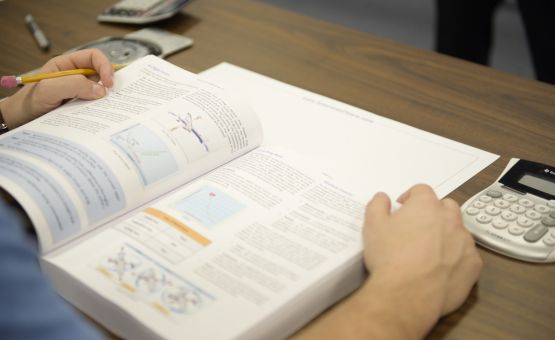You’ve dreamed about flying since you were knee-high to a grasshopper, and you’re finally in a position where this dream will become a reality. Your friends and family know you are training to become a pilot, but only one thing stands between you and your coveted certificate: the FAA Knowledge Exam, otherwise known as “The Written.”
There is a joke that I heard a few years ago that is relevant to this moment. “Two shoe salesmen are sent to a recently discovered tropical island. One salesman reports back that there is no opportunity; the island is full of natives, but none wear shoes. The second salesman writes back to his company that they hit the gold mine. The island is full of potential customers who don’t wear shoes.”
The good news is that the only thing standing between you and your certificate is the written. If you focus on learning the material instead of just memorizing answers, you won’t have any problems. Here are some tips and recommendations to help you prepare for and pass your knowledge exam with an extra edge.
IT’S ALL IN YOUR MIND: If you approach the class with the intent to learn, you will. This is an essential part of your pilot training. What better way to spend a weekend than talking about flying with five or ten like-minded individuals?
DON’T MEMORIZE THE ANSWERS: Your goal in a written prep class should be to understand the information, not just memorize the answers. If you learn the information correctly, you won’t have to worry about what question is asked; you will know the answer. We see it hundreds of times each year: those who memorize answers often take twice as long to prepare for the written. In the end, they end up paying an instructor to teach them the same information anyway. Do it right the first time.
DON’T WORRY ABOUT YOUR GRADE: Many of our students are successful business people and professionals, and their goal is often to score 100% on the written. The truth is, any score over 70% is passing. Waiting until you feel confident enough to achieve a perfect score will only delay your checkride and prolong your anxiety. At the end of the day, nobody will ever ask you what you scored on your written.
LEARN THE “TIP,” NOT THE “TRICKS”: Many people may offer you their “tricks” for passing the written, but you don’t need tricks if you understand the material. In class, we will provide you with “tips” that help you grasp how the questions are formulated based on what you’re learning. These tips will focus on question phrasing and help you weed out the “almost right” answers.
EAT, DRINK, AND BE MERRY: Make sure you eat well before and during class. Bring a protein snack and a bottle of water, and keep your sugar intake to a minimum. Stay hydrated and avoid frustration. These practices will ensure your mind and body are ready to learn, and maintaining a positive attitude will enhance your motivation for success.
GET SOME REST: Make sure to get a good night’s sleep before your knowledge test. You have up to three hours to complete the exam, and going in tired or groggy may lead you to rush through the second half of the test. Go to sleep early and schedule your test for the first test slot in the morning.
GET TO KNOW THE EXHIBIT BOOK: Every knowledge test comes with an exhibit book given to you before you start. Many of the graphics are also included in the test as well. While preparing for the knowledge test, take some time to look through the exhibit book and make sure you understand what the images convey. Although the FAA no longer publishes possible questions, you can expect that many questions will reference the images in the exhibit book.
READ THE INSTRUCTIONS: Some questions on the knowledge test are about graphs and performance charts. If you’re unfamiliar with one or more of these, don’t panic. Look at the whole graph or chart, as they often contain instructions on how to use them.
WHEN IN DOUBT, DON’T GUESS: The saying “When in doubt, pick C” isn’t always true and does not always work to your benefit. Instead, mark the question and return to it later. The testing software allows you to do this, and oftentimes, subsequent questions can provide clues for answering the marked question. You shouldn’t have to guess; use logic and reasoning to the best of your ability.
YOU DON’T GET THE QUESTION: If you encounter a question you don’t understand, read all the answer options first. This can often provide enough context to help you grasp the original question.
HOUSEKEEPING: Every testing center is different, but while you can’t control the environment, you can control your tools. Ask for at least two full-sized, sharpened pencils with erasers. Nubby pencils and worn-down erasers can lead to sloppiness and mistakes. Your scratch paper should be full-sized (8 ½ x 11) and free of any writing, stains, or marks. Ensure that your plastic graph overlays are smooth, without bends or creases. Your exhibit book, including all graphs and charts, should also be clean and unmarked. Check that your computer monitor is clean, as subtle marks left by previous users can be distracting during the test.
IDENTIFY PROBLEMS EARLY: If there’s a problem with your testing computer, monitor, or mouse, let someone know ASAP. Don’t try to work around it—your focus and concentration should be entirely on your test.
THE TESTING ENVIRONMENT: Your knowledge test is crucial for earning your certificates and ratings, so ensure your testing environment is conducive to focus. Excessive noise, whether from outside or inside the testing room, can be distracting. If you believe noise will be a distraction, tell your test proctor. Make sure the room is well-lit so you can easily read the graphics in the exhibit book.
WHAT DO YOU DO: Before starting the test, clarify with the test proctor what to do if you need to use the restroom. While they will provide instructions, it’s important you understand the process for completing the test and obtaining your results.
BE PREPARED: You’ll need to present certain items to the test proctor before taking your knowledge test. You should organize these the day before and make sure you bring them with you to your test. Consider calling your testing center a day or two in advance to confirm what you need. The critical items are:
Photo I.D. (for U.S. Citizens & resident aliens)
– Driver’s license issued by a U.S. State or territory
– U.S. government I.D. card
– U.S. Military I.D card
– Passport or alien residency card
Photo I.D. (for non-U.S. Citizens)
– Driver’s license issued by a U.S. State or territory and/or
– I.D. card issued by any government entity.
Endorsement (signoff) for the written. Most of the FAA knowledge tests require an endorsement from your flight instructor.
YOU BECOME SO NERVOUS THAT YOU FIND YOURSELF SHUTTING DOWN: If this happens, find your test proctor and ask to get a drink of water and collect yourself. Splash some water on your face and drink to regroup so you can continue.
THERE IS A QUESTION THAT STANDS OUT FROM THE OTHERS IN HOW IT IS PHRASED OR DEALS WITH A SUBJECT THAT YOU MAY NOT BE ALL THAT FAMILIAR WITH: This is normal. Occasionally, the FAA includes ample test questions to evaluate their effectiveness and relevance to current events. If you come across one of these, don’t panic. Read the question and the answer choices carefully, then select the one that makes the most sense to you.
DON’T DO THE MATH IN YOUR HEAD: We see this all of the time. Students often read a question quickly and assume it’s simple, but mental calculations frequently lead to errors. When working on a problem with numbers, write them down on your scratch paper and do the math on the paper. This will help you catch mistakes, especially when the answer options are very close.
LEARN THE ACS ELEMENTS: The FAA publishes the Airman Certification Standards (ACS). These can be found by going to www.faa.gov/training_testing/testing/acs. While you don’t need to memorize them, it’s important to read through these elements, as they cover all the areas included in the FAA knowledge test. After your test, you can review the relevant element with your instructor based on any questions you may have missed.










